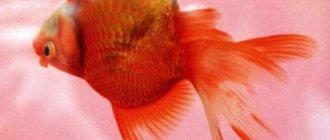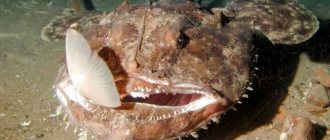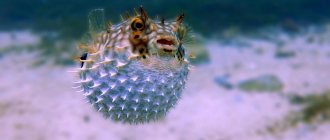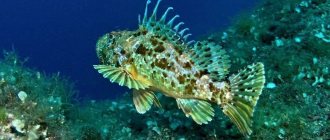- Wild animals
- >>
- Fish
The anglerfish is an unusual deep-sea creature, reminiscent of monsters from a fairy tale. Amazing and unlike others. All external features are adapted to live under a huge thickness of water, in dark and impenetrable depths. Let's try to study their mysterious fish life in more detail, focusing not only on appearance, but also on characteristic habits, disposition, methods of reproduction and food preferences.
Origin of the species and description
Photo: Anglerfish
Anglerfish are also called sea devils; they belong to the suborder of deep-sea ray-finned fish, to the order Anglerfishes. The kingdom of these fish is located at great ocean depths. Scientists believe that the appearance of the very first anglerfish on Earth occurred more than 100 million years ago. Despite this, these amazing fish are still very poorly studied, apparently due to their deep-sea existence.
Video: Anglerfish
In general, all anglerfish are distinguished by extraordinary and strange external features, necessary for fish to live at great depths. The main difference between anglerfish is their modified dorsal fin, which hangs close to the fish’s mouth and resembles a fishing rod with a bait (eska) at the end. This unusual fishing rod is called illicium, and because of its presence of fish, it is nicknamed anglerfish.
Interesting fact: Among angler fish, only females have a fishing rod.
All anglers are divided into 11 families, which consist of more than 120 species of fish. Different types differ not only in places of permanent deployment, but also in size, weight, and some external features.
Among the varieties are:
- black-bellied (South European) anglerfish;
- Far Eastern anglerfish;
- American anglerfish;
- European anglerfish;
- Western Atlantic anglerfish;
- cape anglerfish;
- South African anglerfish.
Fishing rods for females have a different structure, shape and size, it all depends on the type of fish. Various skin growths are possible on illicia. Some anglers have the ability to fold and expand using a special channel on the spine. The esca, shimmering in the darkness, is a gland that is filled with mucus containing bioluminescent bacteria. The fish itself causes the glow or stops it, expanding and narrowing the blood vessels. The light and flashes from the bait are different and individual for each type of fish.
general information
Monkfish belongs to the ray-finned fish of the anglerfish family
. An adult fish grows up to 2 meters in length and weighs at least 20 kg. But most often you come across individuals up to 1 meter in size and weighing up to 10-12 kg. The sea devil has a flattened, disproportionate body and a very large head, which can occupy 2/3 of the body. Colored brown with a greenish or red tint. The abdominal cavity is white.
The mouth is large and wide with sharp and concave teeth. The skin has no scales. The eyes are quite small, seeing almost nothing, and the sense of smell is also very poorly developed. Around the anglerfish's mouth there are folds that periodically move, creating the appearance of algae.
The anglerfish has a disproportionately large head and reaches quite impressive sizes.
The front fin plays a special role in the life of a fish. It has six rays, half of which grow separately. One of them hangs forward and forms a fishing rod, thanks to which the fish received another name - the European anglerfish. The rod is equipped with a base, fishing line (the thin part) and a luminous bait.
Appearance and features
Photo: What an anglerfish looks like
As already noted, the female differs from the male in the presence of a special fishing rod used to attract prey. But the differences between the sexes don’t end there; male and female anglerfish are so different that scientists used to classify them as different species. Male and female fish vary greatly in size.
The females are simply giants compared to their males. The dimensions of females can vary from 5 cm to two meters, the weight can reach up to 57 kg, and the length of males does not exceed 5 cm. These are the colossal differences in parameters! Another sexual dimorphism lies in the fact that miniature cavaliers have excellent vision and sense of smell, which they need to detect a partner.
The sizes of anglerfish vary among different species; we will describe some of them. The length of the body of the European anglerfish can reach up to two meters in length, but, on average, it does not exceed one and a half meters. The largest mass of such a large fish ranges from 55 to 57.7 kg. The body of the fish is devoid of scales; it is replaced by many leathery growths and tubercles. The body of the fish is flattened, compressed from the ridge and abdomen. The eyes are small and located quite far from each other. The fish's spine has a brown or greenish-brown tint, there is also a reddish tone, and there may be dark spots on the body.
The length of the American anglerfish ranges from 90 to 120 cm, and its weight is about 23 kg. The dimensions of the black-bellied anglerfish vary from half a meter to a meter. The length of the Western Atlantic anglerfish does not exceed 60 cm. The Cape monkfish has a huge head, which is noticeably flattened, and the fish’s tail is short. The length of this fish usually does not exceed the meter mark.
The Far Eastern anglerfish grows up to one and a half meters, its head section is very wide and flattened. Immediately noticeable is the large mouth and the lower jaw, which is pushed forward, which is equipped with one or two rows of sharp teeth. The fins located on the chest are quite wide and have a fleshy blade. On top, the fish is colored brown with spots of a lighter shade, which are framed by a dark border. The belly has a lighter shade.
Interesting fact: Sea devils move along the bottom surface using jumps, which they can make thanks to their strong pectoral fins.
In general, angler fish are simply masters of camouflage; they completely merge with the bottom, becoming practically indistinguishable from the ground. All sorts of bumps and growths on their body contribute to this. On both sides of the head, angler fish have overhanging skin in the form of a fringe, which also runs along the jaw, above the fish lips. Externally, this fringe is similar to algae swaying in the water column, because of this the fish camouflages itself even more closely with its surroundings.
Interesting fact: An anglerfish caught from the depths looks completely different from what it does at the bottom. He becomes swollen, and his eyes seem to be coming out of their sockets, the whole point is due to excess pressure, which at a depth reaches 300 atmospheres.
Cooking creamy soup
The meat of angler fish is dense, and pieces of fish do not boil over in soups. Therefore, the dishes not only turn out tasty, but also look attractive.
To prepare creamy soup, you need the following ingredients:
- monkfish carcass or fillet;
- bulb;
- carrot;
- several potato tubers;
- cream (can be replaced with melted cream cheese);
- greenery;
- salt and spices.
How to cook creamy monkfish soup:
- We cut the fish, put it in a pan and let it cook, adding a little salt. When the water boils, you will need to regularly skim off the floating foam.
- We peel the potatoes, cut them as convenient, and when the fish stops producing foam, put them in the broth.
- Chop the onions and carrots, fry them and add them to the soup after the potatoes reach the half-cooked stage.
- Wait until it boils, add cream or cream cheese, add chopped herbs and leave the dish on low heat for about 5-7 minutes.
Fish soup should be served with pieces of white or black bread. And if you have time, you can make croutons.
Where does the anglerfish live?
Photo: Anglerfish underwater
Anglerfish inhabit great depths, ranging from one and a half to three and a half kilometers. They have long adapted to the darkness and excess pressure in the ocean waters. The black-bellied monkfish lives in the eastern part of the Atlantic Ocean, having chosen the space from Senegal to the islands of Britain.
This anglerfish lives in the waters of the Black and Mediterranean Seas. From the name it is clear that the Western Atlantic anglerfish is registered in the western part of the Atlantic, living in depths from 40 to 700 meters.
The American anglerfish inhabits the Atlantic coast of the North American continent; it is based in the northwestern part of the Atlantic at a depth of 650 to 670 meters. The European monkfish has also taken a liking to the Atlantic, but is stationed not far from the European shores; its habitat extends from the waters of the Barents Sea and Iceland to the Gulf of Guinea; the fish also lives in the Black, Baltic and North Seas.
The Far Eastern angler fish likes the Sea of Japan; it lives along the coastal zone of Korea, in Peter the Great Bay, near the island of Honshu. Now you know where the angler fish are found. Let's see what this deep-sea fish eats.
Habitats
Monkfish lives in many seas and oceans. The European anglerfish is widespread in the Atlantic Ocean. Here he lives at a depth of 20 meters or more
. It is also caught along the coast of European water bodies, in the Barents and North Seas.
Hatched young fish differ from adult fish. At first, the fry feed on plankton, live in the upper layers of the reservoir, and when they reach a length of 10 cm, they change appearance. Then they move closer to the bottom and begin to lead a predatory lifestyle. In the first year after birth they grow very quickly.
Not long ago, related species of anglerfish were discovered. They began to be called deep-sea anglerfish. Individuals can withstand very high water pressure and are found at a depth of about 2 km.
What does an anglerfish eat?
Photo: Anglerfish
Monkfish are predators whose menu is mainly fish. Deep-sea fish can become a snack for the anglerfish, which stubbornly awaits them in ambush.
These fish include:
- hauliodaceae;
- gonostomaceae;
- hatchet or hatchet fish;
- Melamphaev.
In the stomachs of caught anglers they found gerbils, small stingrays, cod, eels, small sharks, and flounder. Species that live less deeply prey on herring and mackerel. There is evidence that anglerfish have attacked small waterfowl. Sea devils eat crustaceans and cephalopods, including snacking on cuttlefish and squid. Small males eat copepods and chaetognaths.
The hunting process of monkfish is a very exciting spectacle. Hiding and camouflaged at the bottom, the fish highlights its bait (esku), located at the end of the rod, it begins to play with it, making movements similar to the swimming of a small fish. The female has a lot of patience; she steadfastly waits for her prey. The anglerfish sucks a medium-sized victim into itself with lightning speed. It also happens that the fish has to make an attack, which is carried out in a jump. The jump is possible thanks to the powerful repelling pectoral fins or the release of a water jet through the gills.
Interesting fact: When a fish's large mouth opens, something like a vacuum is formed, so the prey, along with the flow of water, is quickly sucked into the anglerfish's mouth.
The gluttony of anglers often plays a cruel joke on them. The stomach of females has the ability to stretch very strongly, so their prey can be three times larger in size than the fish itself. The angler choke on such large prey and is unable to spit it out, because... The fish's teeth point inward, so it suffocates and dies.
Features of character and lifestyle
Photo: Anglerfish
Little is known about the character and life activity of monkfish; in this regard, they have not yet been studied enough. These mysterious deep-sea creatures are shrouded in mystery. Scientists have found that a large female sees almost nothing and has a weak sense of smell, while males, on the contrary, vigilantly look out for a partner not only with the help of sight, but also smell. To identify a female fish that belongs specifically to their species, they pay attention to the fishing rod, the shape of the bait and its glow.
The character of these deep-sea fish is seen in a certain way through the relationship between the male and female, which is unique in some species of anglerfish. Among these extraordinary fish, there is such a phenomenon as parasitism of males.
It is characteristic of four families of anglerfish:
- linofrine;
- ceratiaceae;
- novoceratiids;
- caulofrines.
This unusual symbiosis manifests itself in the fact that the male parasitizes the female’s body, gradually turning into her appendage. Having seen his partner, the male literally bites into her with the help of his sharp teeth, then he begins to fuse with her with his tongue and lips, gradually turning into an appendage on the body, necessary in order to produce sperm. While feeding, the female also feeds the gentleman attached to her.
Interesting fact: On the body of one female anglerfish there can be six males at once, which are necessary in order to begin fertilizing the eggs at the right moment.
Curious facts
The surrendered fish is associated with the following interesting facts:
- When buying a female anglerfish on the market, quite often you can buy not 1, but 2 fish at once. The male in adult females is attached to one of the sides. Sometimes it manages to form a shoot, losing its original appearance.
- Today, commercial fishing of this fish is prohibited in the USA and Britain. Therefore, it is impossible to find it in large supermarkets. You can try real monkfish either in one of the Mediterranean countries or in Asia.
- There are several varieties, and they all look different. How different the body shape and appearance of different monkfish differ can be seen in the photograph.
- The anglerfish is believed to have existed in prehistoric times, becoming one of the first species of marine fish.
Social structure and reproduction
Photo: Deep sea anglerfish
Sexual maturity occurs in different varieties at different ages. For example, male European monkfish become sexually mature closer to six years of age, and females are able to reproduce only at 14 years old, when their length reaches a meter. The spawning period for these extraordinary fish does not occur at the same time for all of them. Fish populations living in the north go to spawn from March to May. Fish living further south spawn from January to June.
During the wedding fishing season, anglerfish ladies and their gentlemen spend their time at a depth of 40 meters to 2 km. Having descended to a depth, the female begins to spawn, and the males fertilize the eggs. After this, the fish rush to shallow water, where they begin to eat. From the eggs of anglerfish, whole ribbons are formed, which are covered with mucus on top. The width of such a tape can be from 50 to 90 cm, its length ranges from 8 to 12 meters, and its thickness does not exceed 6 mm. Such ribbon rafts of eggs, which contain about a million of them, drift in sea waters, and the eggs in them are located in special hexagonal cells.
After some time, the cellular walls are destroyed, and the eggs are already free floating. The hatched larvae of anglerfish exist in the upper water layers for two weeks. They are distinguished from adult fish by their body shape, which is not flattened; the fry have fairly large pectoral fins. At first they feed on small crustaceans and eat eggs and larvae of other fish.
Interesting fact: The size of the eggs can vary, depending on the type of fish. In the European anglerfish, the caviar varies in diameter from 2 to 4 mm, in the American monkfish it is smaller, its diameter ranges from 1.5 to 1.8 mm.
As they develop and grow, the fry of anglerfish are constantly changing, gradually becoming similar to their mature relatives. When the length of their body reaches 8 mm, the fish move to live from the surface to a deeper level. In the first year of life, sea devils grow very rapidly, then the pace of their development proceeds much more slowly. The lifespan given to anglerfish by nature varies depending on the type of fish, but the longest-lived among these deep-sea inhabitants is the American monkfish, which can live about 30 years.
Nutrition
Mainly, other, usually smaller, fish serve as food for these fish. The monkfish menu consists of Katrans, Silversides, Kalkans, Stingrays and others.
In general, the monkfish is incredibly voracious and therefore boldly rushes even at a seemingly obviously unattainable goal. And in “hungry” moments, a large anglerfish, suffering from an almost complete lack of vision, rises to the upper layers of water from the depths and at such moments it is capable of attacking scuba divers. You can meet such an inhabitant of the deep sea just at the end of summer, after a grueling hungry spawning, the “devils” go to shallow water, where they eat intensively until the fall, after which they go to wintering in greater depths.
However, compared to sharks, barracudas and octopuses, true sea devils or anglerfish do not pose an immediate danger to humans
Be that as it may, their terrible teeth can disfigure the hand of an unwary fisherman for life. However, the monkfish causes much more damage not to humans, but to other commercial fish species
Thus, there are legends among fishermen that, having fallen into a fishing net, he ate the fish that got there while he was there.
This is interesting: What is the difference between sterlet and sturgeon - differences, what is the difference, how to tell the difference, photo
Natural enemies of the anglerfish
Photo: Male anglerfish
The angler fish has practically no enemies in natural conditions. Apparently, this is due to its very deep-sea lifestyle, terrifying external features and unsurpassed talent for camouflage. It is almost impossible to see such a fish at the bottom, because it merges with the surface soil to such an extent that it forms one whole with it.
As already mentioned, one’s own greed for food and excessive gluttony often ruin fish’s lives. The anglerfish swallows prey that is too large, which causes it to choke on it and die, because it is not able to spit it out due to the special structure of its teeth. It is not uncommon to find prey in the stomachs of caught monkfish, which is only a few centimeters smaller in size than the predator fish itself.
The enemies of anglers include people who fish for this extraordinary fish. Monkfish meat is considered a delicacy; it has practically no bones and has a dense consistency. Most of this fish is caught in the UK and France.
Interesting fact: There is evidence that every year from 24 to 34 thousand tons of the European variety of anglerfish are caught all over the world.
Angler fish meat has a sweetish and delicate taste, it is not at all fatty. But they mainly use the tail part of the fish for food, and everything else, as a rule, is considered waste.
Eating
Despite its habitat and unusual description of its appearance, the anglerfish is used as food. There are interesting recipes with this fish. But, you should take into account the characteristics of the meat in order to prepare a tasty dish. It is depleted in fat and loses moisture quite quickly. Especially if you freeze it. Therefore, in order to preserve the elasticity of muscle fibers and the taste of the finished product, it is better to buy such fish fresh or chilled.
Most often, anglerfish are caught in small quantities. The catch is mainly made in the northern regions, since here the fish come closer to the shore. In the southern warm coastal waters, only a few species live, so commercial fishing is practically not carried out here.
Where anglerfish is a traditional part of national cuisine, quite tasty dishes are prepared from it. Light meat has a rich flavor with a slight sweetness. As it cooks, it becomes denser. Not only the tail part can be eaten, but also caviar, liver, and fish soup is sometimes cooked from the fins. It is quite often called the tail sea creature. This is due to the fact that only here can the edible part be found; the rest of the body is occupied by the head.
You can judge what the fillet or tail part of this fish looks like from the photograph.
Population and species status
Photo: What an anglerfish looks like
As previously reported, the anglerfish is a commercial fish. To catch it, special bottom trawls and gill nets are used, so deep-sea habitat does not save this unusual fish. The catching of European monkfish by the thousands of tons is leading to a decline in its population, which is worrying. The fish suffers because of its dense and tasty meat, which has almost no bones. The French especially know a lot about monkfish dishes.
The Western Atlantic anglerfish is caught in Brazil; 9 thousand tons are caught annually around the world. Angler fishing on a large scale has resulted in the fish becoming rare in certain habitats and considered endangered. This, for example, happened with the American monkfish, of which there are very few left due to overfishing, which causes concern among many environmental organizations.
So, the population of anglerfish is declining. The love for delicious fish meat led some species to the threat of extinction, because this fish was caught in huge quantities. In some countries and regions, the anglerfish is considered to be listed in the Red Book and requires special protective measures so as not to completely disappear from the deep sea.
Approximately how much does it cost?
Anglerfish, called yellow angler (Lophius piscatorius), monkfish with footfish - this exotic fish is bred in public aquariums. The price of one fish is 110-180 dollars.
The depths of the deep-sea kingdom are fraught with many unsolved mysteries and secrets. The monkfish has not yet been fully studied, and other original inhabitants also arouse interest and curiosity.
I would like the reader, after reading the material, to share his impressions and leave a comment.











